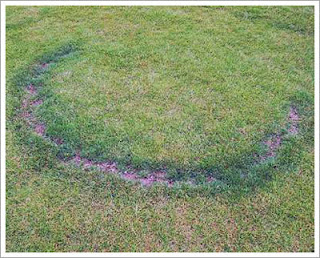Fairy Rings which are caused by fungi start to show signs of activity during the end of spring or early summer. They are easily recognisable with distinct dark green rings and/or fruiting bodies including mushrooms, toadstools and puffballs. The rings can be full or part circle.
Although there are thousands of types of fungi that cause these rings, there are in fact only 3 types of Fairy Ring, each having different characteristics. Fairy Rings start from a central point and gradually increase in size, with the rings getting larger as time passes. In most cases they increase about 80mm - 150mm in size each year.
Fairy Rings degrade the organic matter in the lawn, it is then broken down by micro organisms and released as nitrogen. The nitrogen is then made available for plant uptake, giving the lawn its distinct dark green ring.
They can be found in all types of lawns and turf, including luxury lawns, golf greens, sports fields and neglected turf.
There are 3 types of Fairy Ring.
- Type 1 fairy ring: This type of Fairy Ring is the most destructive and damaging as it produces a ring of dead grass. The dead area can contain fruiting bodies in the form of mushrooms, toadstools and puffballs. If a section of soil is removed from the dead area, white thread or hair like structures called mycelium will be visible in the soil. Mycelium is hydrophobic (water repellant) and it is this that produces the dry patch, causing the grass to die.
- Type 2 fairy ring: Type 2 fairy rings are identified by their dark green rings, with or without fruiting bodies. In fact it is similar to a type 1 fairy ring without the dead ring of grass. At worst this type of ring can appear unsightly with its lush growth, accompanied with fruiting bodies.
- Type 3 fairy ring: The most inconspicuous type of Fairy Ring, as the dark ring of grass is absent. Only the ring of fruiting bodies will be visible at different times of the year. The least damaging of the 3 types.
Fairy Rings can be masked with applications of nitrogen when they appear. Nitrogen produces dark green grass growth helping the remaining lawn blend in well with the Fairy Ring. However it is important to apply excessive nitrogen, as it can lead to other lawn or turf problems.
If you are dealing with a type 1 Fairy Ring regularly soaking the infected area and treating it with a wetting agent may help. However this should be undertaken before the soil gets too dry, or it may prove very difficult to re-wet.
The final option is to remove the Fairy Ring from the lawn, golf green etc, by digging it out. Remove all of the soil from inside the ring and 500mm from the outside edge the ring, this needs doing to a depth of 300mm.
It is important not to drop any of the infected soil onto the healthy turf, so take extreme care when doing this task. Replace the soil that has been removed with fresh soil and re-seed. This method is only recommended as a last resort.
Although fungicides are available for Fairy Rings results may be mixed and in many cases unsuccessful. Many gardeners can accept types 2 & 3, it is type 1 that gives the most problems.




























